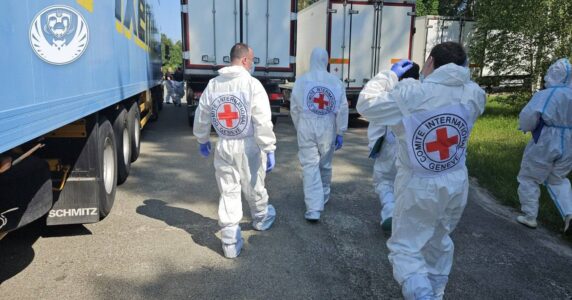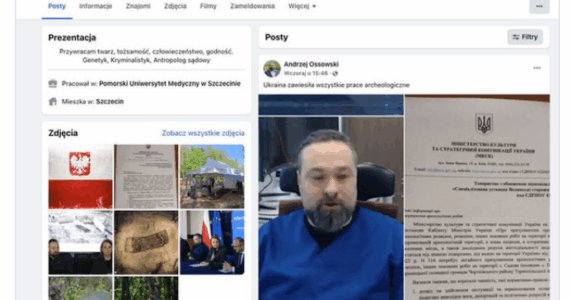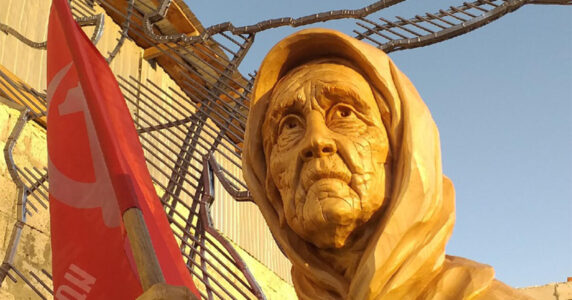Navigation and useful materials
The Centre for Strategic Communication looks back on and refutes key myths of Russian propaganda around the conflict in the east of Ukraine during 2014-2022.
1. “Hear the Donbas!”
Russian propaganda often appeals to the allegedly powerless position of the Donbas within Ukraine. Allegedly, Kyiv did not respect the region, did not consider its interests, therefore did not leave it any other way than separation.
In fact, it is a lie and a manipulation. Most of the time during 1991-2014, the presidents of Ukraine were the favourites of the voters from Donetsk and Luhansk oblasts. The last of them, Yanukovych, not only came from the Donbas, but also brought the so-called “Donetsk clan” to power in the country.
The Donbas is not only supporters of Putin and Yanukovych. In 2014, there was a powerful movement for the unity of Ukraine in the cities of Donetsk and Luhansk oblasts. Hundreds of thousands of people left so as not to live in the Russian occupation. Tens of thousands of residents from the east of Ukraine are fighting as part of the Defence Forces.
The life of the region is forever divided into “before” and “after.” The symbols of the Ukrainian Donbas were the “Donbas Arena” and hosting the international championship Euro 2012. The symbols of the occupation are the Izolyatsiaconcentration camp and the mobilization of the citizens as “cannon fodder” to fight against their own country.
2. “Novorossiya” and “People’s Republics”
Putin and his henchmen like to repeat that Russian historical lands, where Russian people live, who above all seek reunification with Russia, accidentally found themselves as part of Ukraine.
In 2014, to satisfy Moscow’s appetites, instead of the regions of the south and east of Ukraine, “Novorossiya” and “People’s Republics” were invented. This pseudo-historical construction is shaky because it stands on a loose foundation of lies.
Novorossiya is nothing more than the name of several administrative formations of the Russian Empire. Since the beginning of mass colonization in the 18th century, the Ukrainian population has steadily prevailed here, which gave grounds to include this region in the Ukrainian People’s Republic, and later in Soviet Ukraine.
The Donbas has been part of Ukraine for as long as the most modern Ukrainian statehood exists — more than a hundred years. And in 1991, almost 84% of residents of Donetsk and Luhansk oblasts voted for Ukrainian independence.
3. “Ukraine attacked first”
Ukraine never attacked any neighbouring country. Donetsk and Luhansk oblasts are also Ukraine, its integral part, and Ukraine could not attack itself by definition.
In early 2014, the state was agitated by the revolution and weakened by the fact that its pro-Russian authorities fled abroad. In some regions, “anti-Maidan” supporters of Yanukovych remained united. Russia took advantage of their sentiments for its hybrid invasion.
Russian agents, in particular the armed militants of Igor Girkin, began to seize cities in the east, proclaiming not only disagreement with the new authorities in Kyiv, but also a break with the Ukrainian state. They were the first to open fire: on April 13, SSU officer Hennadii Bilichenko was killed. In the following days, the killings continued.
The situation getting out of control and the threat of a repetition of the Crimean scenario prompted the leadership of Ukraine to announce the ATO on April 14. The very name of the operation did not provide for a full-scale conflict. Its purpose was to restore peace and constitutional order in the region. However, the militants, with the increasing involvement of Russia, resorted to escalation, assassinations, and terrorist attacks, exacerbating the war.
4. “Russia has nothing to do with this”
The Russian propaganda presented the events in such a way as though ordinary miners and tractor drivers, who bought the gear in the military store, rebelled in the Donbas and took possession of military equipment and weapons in battle as trophies.
In fact, if it were not for Russia, then no ATO would be needed at all, and Donetsk and Luhansk would be now peaceful and flourishing European cities. The plan to dismember Ukraine was developed in Moscow as a punishment for Ukrainians’ unwillingness to live with Yanukovych and integrate with Russia.
The Russians supplied the militants and their agents with weapons and military equipment. Soon, the servicemen of the armed forces of Russia were seen in the Donbas. Russian artillery and aviation shelled the ATO forces across the border. Subsequently, whole battalion tactical groups from Russia entered Ukraine. They saved the militants and mercenaries from imminent defeat.
At the Minsk talks, Putin pretended to be a neutral mediator and peacemaker. But it was him to whom everyone appealed, demanding to stop the offensive in the Donbas. There were no doubts that anti-Ukrainian formations were dependent on, subordinate to, and controlled by Moscow. And that is why, for non-compliance with the Minsk agreements, the EU imposed its sanctions on Russia.
5. “Where have you been for eight years?”
Opposing the protests against the full-scale invasion and their barbaric bombing, Russians are trying to present their actions as retribution for the allegedly similar behaviour of Ukraine in relation to the Donbas. However, it is enough to compare the almost undestroyed Donetsk and Luhansk with the ruins of Mariupol and Popasna to understand the absolute falsity of such an argument.
Propaganda decided to take advantage of the shock of Ukrainians from the events of February-March 2022 to rewrite history and replace the memory of the events that had preceded them. In fact, collaborators and hybrid Russian troops in the east of Ukraine constantly violated the ceasefire, which affected not only the military, but also the civilian population of the frontline territories.
Russia violated the ceasefire almost immediately after the signing of Minsk-1 in autumn 2014. Soon, large-scale battles broke out for the Donetsk airport and Debaltseve. To stop this, there were another negotiations in Minsk to sign a new agreement — Minsk-2. Until recently, Ukraine hoped for a diplomatic settlement of the conflict. President Volodymyr Zelenskyy took unprecedented steps to de-escalate the situation. This happened at a time when Putin was planning his full-scale invasion.
Centre for Strategic Communication and Information Security
If you have found a spelling error, please, notify us by selecting that text and pressing Ctrl+Enter.


